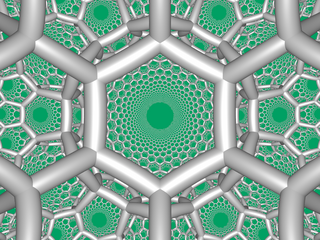| Hexagonal tiling honeycomb | |
|---|---|
 Perspective projection view within Poincaré disk model | |
| Type | Hyperbolic regular honeycomb Paracompact uniform honeycomb |
| Schläfli symbols | {6,3,3} t{3,6,3} 2t{6,3,6} 2t{6,3[3]} t{3[3,3]} |
| Coxeter diagrams | |
| Cells | {6,3} |
| Faces | hexagon {6} |
| Edge figure | triangle {3} |
| Vertex figure |  tetrahedron {3,3} |
| Dual | Order-6 tetrahedral honeycomb |
| Coxeter groups | , [3,3,6] , [3,6,3] , [6,3,6] , [6,3[3]] , [3[3,3]] |
| Properties | Regular |
In the field of hyperbolic geometry, the hexagonal tiling honeycomb is one of 11 regular paracompact honeycombs in 3-dimensional hyperbolic space. It is paracompact because it has cells composed of an infinite number of faces. Each cell is a hexagonal tiling whose vertices lie on a horosphere, a surface in hyperbolic space that approaches a single ideal point at infinity.
The Schläfli symbol of the hexagonal tiling honeycomb is {6,3,3}. Since that of the hexagonal tiling is {6,3}, this honeycomb has three such hexagonal tilings meeting at each edge. Since the Schläfli symbol of the tetrahedron is {3,3}, the vertex figure of this honeycomb is a tetrahedron. Thus, four hexagonal tilings meet at each vertex of this honeycomb, six hexagons meet at each vertex, and four edges meet at each vertex.[1]
- ^ Coxeter The Beauty of Geometry, 1999, Chapter 10, Table III




